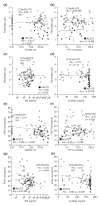Disseminated intravascular coagulation or acute coagulopathy of trauma shock early after trauma? An observational study
- PMID: 22087841
- PMCID: PMC3388658
- DOI: 10.1186/cc10553
Disseminated intravascular coagulation or acute coagulopathy of trauma shock early after trauma? An observational study
Abstract
Introduction: It is debated whether early trauma-induced coagulopathy (TIC) in severely injured patients reflects disseminated intravascular coagulation (DIC) with a fibrinolytic phenotype, acute coagulopathy of trauma shock (ACoTS) or yet other entities. This study investigated the prevalence of overt DIC and ACoTS in trauma patients and characterized these conditions based on their biomarker profiles.
Methods: An observational study was carried out at a single Level I Trauma Center. Eighty adult trauma patients (≥18 years) who met criteria for full trauma team activation and had an arterial cannula inserted were included. Blood was sampled a median of 68 minutes (IQR 48 to 88) post-injury. Data on demography, biochemistry, injury severity score (ISS) and mortality were recorded. Plasma/serum was analyzed for biomarkers reflecting tissue/endothelial cell/glycocalyx damage (histone-complexed DNA fragments, Annexin V, thrombomodulin, syndecan-1), coagulation activation/inhibition (prothrombinfragment 1+2, thrombin/antithrombin-complexes, antithrombin, protein C, activated protein C, endothelial protein C receptor, protein S, tissue factor pathway inhibitor, vWF), factor consumption (fibrinogen, FXIII), fibrinolysis (D-dimer, tissue-type plasminogen activator, plasminogen activator inhibitor-1) and inflammation (interleukin (IL)-6, terminal complement complex (sC5b-9)). Comparison of patients stratified according to the presence or absence of overt DIC (International Society of Thrombosis and Hemostasis (ISTH) criteria) or ACoTS (activated partial thromboplastin time (APTT) and/or international normalized ratio (INR) above normal reference).
Results: No patients had overt DIC whereas 15% had ACoTS. ACoTS patients had higher ISS, transfusion requirements and mortality (all P < 0.01) and a biomarker profile suggestive of enhanced tissue, endothelial cell and glycocalyx damage and consumption coagulopathy with low protein C, antithrombin, fibrinogen and FXIII levels, hyperfibrinolysis and inflammation (all P < 0.05). Importantly, in non-ACoTS patients, apart from APTT/INR, higher ISS correlated with biomarkers of enhanced tissue, endothelial cell and glycocalyx damage, protein C activation, coagulation factor consumption, hyperfibrinolysis and inflammation, that is, resembling that observed in patients with ACoTS.
Conclusions: ACoTS and non-ACoTS may represent a continuum of coagulopathy reflecting a progressive early evolutionarily adapted hemostatic response to the trauma hit and both are parts of TIC whereas DIC does not appear to be part of this early response.
Figures


References
-
- Peden M, McGee K, Krug E. In: Injury: A Leading Cause of the Global Burden of Disease, 2000. Peden M, McGee K, Krug E, editor. Geneva, Switzerland: World Health Organization; 2002.
-
- Sauaia A, Moore FA, Moore EE, Haenel JB, Read RA, Lezotte DC. Early predictors of postinjury multiple organ failure. Arch Surg. 1994;129:39–45. - PubMed
Publication types
MeSH terms
Substances
LinkOut - more resources
Full Text Sources
Medical
Miscellaneous

